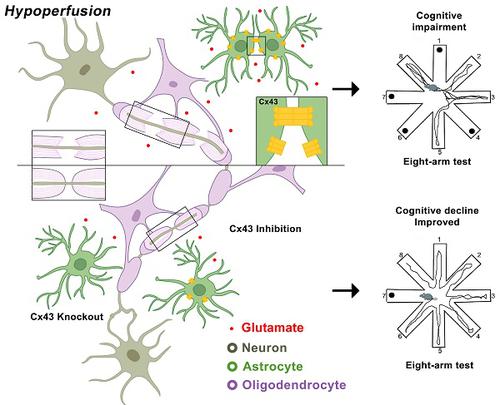当前位置:
X-MOL 学术
›
Theranostics
›
论文详情
Our official English website, www.x-mol.net, welcomes your
feedback! (Note: you will need to create a separate account there.)
Astrocytic connexin 43 potentiates myelin injury in ischemic white matter disease.
Theranostics ( IF 12.4 ) Pub Date : 2019-06-09 , DOI: 10.7150/thno.31942 Minghuan Wang 1 , Chuan Qin 1 , Xiang Luo 1 , Jie Wang 2 , Xuxia Wang 2 , Minjie Xie 1 , Jing Hu 1 , Jie Cao 1 , Ting Hu 2 , Steven A Goldman 3, 4, 5 , Maiken Nedergaard 3, 4 , Wei Wang 1, 6
Theranostics ( IF 12.4 ) Pub Date : 2019-06-09 , DOI: 10.7150/thno.31942 Minghuan Wang 1 , Chuan Qin 1 , Xiang Luo 1 , Jie Wang 2 , Xuxia Wang 2 , Minjie Xie 1 , Jing Hu 1 , Jie Cao 1 , Ting Hu 2 , Steven A Goldman 3, 4, 5 , Maiken Nedergaard 3, 4 , Wei Wang 1, 6
Affiliation

|
Rational: Myelin loss is a characteristic feature of both ischemic white matter disease and its associated vascular dementia, and is a hallmark of chronic cerebral hypoperfusion due to carotid artery stenosis. Yet the cellular mechanisms involved in ischemic dysmyelination are not well-understood, and no effective treatment has emerged to prevent or slow hypoperfusion-related demyelination. In a study employing the bilateral common carotid artery stenosis (BCAS) mouse model, we found reduced cerebral blood flow velocity and arteriolar pulsatility, and confirmed that prolonged BCAS provoked myelin disruption. These pathological features were associated with marked cognitive decline, in the absence of evident damage to axons. Methods: To assess the role of astroglial communication in BCAS-associated demyelination, we investigated the effect of deleting or inhibiting connexin 43 (Cx43), a constituent of astroglial gap junctions and hemichannels. Results: Genetic deletion and pharmacological inhibition of gap junctions both protected myelin integrity and rescued cognitive decline in the BCAS-treated mice. Gap junction inhibition also suppressed the transient increase in extracellular glutamate observed in the callosal white matter of wild-type mice exposed to BCAS. Conclusion: These findings suggest that astrocytic Cx43 may be a viable target for attenuating the demyelination and cognitive decline associated with chronic cerebral hypoperfusion.
中文翻译:

在缺血性白质病中,星形胶质细胞连接蛋白43增强髓磷脂的损伤。
理智:髓磷脂的丢失是缺血性白质病及其相关的血管性痴呆的特征,并且是由于颈动脉狭窄导致的慢性脑灌注不足的标志。然而,与缺血性髓鞘异常有关的细胞机制尚未得到很好的理解,并且尚未出现有效的治疗方法来预防或减缓与灌注不足相关的脱髓鞘。在一项采用双侧颈总动脉狭窄(BCAS)小鼠模型的研究中,我们发现脑血流速度降低和小动脉搏动降低,并证实长时间的BCAS会引起髓磷脂破坏。这些病理特征与明显的认知能力下降有关,而对轴突没有明显的损害。方法:评估星形胶质细胞沟通在BCAS相关脱髓鞘中的作用,我们研究了删除或抑制连接蛋白43(Cx43)的作用,连接蛋白43是星形胶质间隙连接和半通道的组成部分。结果:BCAS处理的小鼠的遗传缺失和缝隙连接的药理抑制作用既保护了髓鞘的完整性,又挽救了认知能力的下降。间隙连接抑制还抑制了暴露于BCAS的野生型小鼠the体白质中观察到的细胞外谷氨酸的瞬时增加。结论:这些发现表明,星形胶质细胞Cx43可能是减轻与慢性脑灌注不足相关的脱髓鞘和认知能力下降的可行靶标。遗传删除和缝隙连接的药理学抑制作用既保护了髓鞘完整性,又挽救了BCAS治疗小鼠的认知能力下降。间隙连接抑制还抑制了暴露于BCAS的野生型小鼠the体白质中观察到的细胞外谷氨酸的瞬时增加。结论:这些发现表明,星形胶质细胞Cx43可能是减轻与慢性脑灌注不足相关的脱髓鞘和认知能力下降的可行靶标。在BCAS处理的小鼠中,间隙连接的遗传缺失和药理抑制作用既保护了髓鞘的完整性,又挽救了认知能力的下降。间隙连接抑制还抑制了暴露于BCAS的野生型小鼠the体白质中观察到的细胞外谷氨酸的瞬时增加。结论:这些发现表明,星形胶质细胞Cx43可能是减轻与慢性脑灌注不足相关的脱髓鞘和认知能力下降的可行靶标。
更新日期:2019-01-01
中文翻译:

在缺血性白质病中,星形胶质细胞连接蛋白43增强髓磷脂的损伤。
理智:髓磷脂的丢失是缺血性白质病及其相关的血管性痴呆的特征,并且是由于颈动脉狭窄导致的慢性脑灌注不足的标志。然而,与缺血性髓鞘异常有关的细胞机制尚未得到很好的理解,并且尚未出现有效的治疗方法来预防或减缓与灌注不足相关的脱髓鞘。在一项采用双侧颈总动脉狭窄(BCAS)小鼠模型的研究中,我们发现脑血流速度降低和小动脉搏动降低,并证实长时间的BCAS会引起髓磷脂破坏。这些病理特征与明显的认知能力下降有关,而对轴突没有明显的损害。方法:评估星形胶质细胞沟通在BCAS相关脱髓鞘中的作用,我们研究了删除或抑制连接蛋白43(Cx43)的作用,连接蛋白43是星形胶质间隙连接和半通道的组成部分。结果:BCAS处理的小鼠的遗传缺失和缝隙连接的药理抑制作用既保护了髓鞘的完整性,又挽救了认知能力的下降。间隙连接抑制还抑制了暴露于BCAS的野生型小鼠the体白质中观察到的细胞外谷氨酸的瞬时增加。结论:这些发现表明,星形胶质细胞Cx43可能是减轻与慢性脑灌注不足相关的脱髓鞘和认知能力下降的可行靶标。遗传删除和缝隙连接的药理学抑制作用既保护了髓鞘完整性,又挽救了BCAS治疗小鼠的认知能力下降。间隙连接抑制还抑制了暴露于BCAS的野生型小鼠the体白质中观察到的细胞外谷氨酸的瞬时增加。结论:这些发现表明,星形胶质细胞Cx43可能是减轻与慢性脑灌注不足相关的脱髓鞘和认知能力下降的可行靶标。在BCAS处理的小鼠中,间隙连接的遗传缺失和药理抑制作用既保护了髓鞘的完整性,又挽救了认知能力的下降。间隙连接抑制还抑制了暴露于BCAS的野生型小鼠the体白质中观察到的细胞外谷氨酸的瞬时增加。结论:这些发现表明,星形胶质细胞Cx43可能是减轻与慢性脑灌注不足相关的脱髓鞘和认知能力下降的可行靶标。











































 京公网安备 11010802027423号
京公网安备 11010802027423号